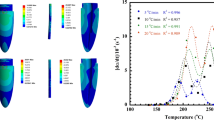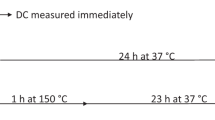Abstract
In this paper we report on the morphogenesis of dental resins formed by a thermally initiated radical cross-linking copolymerization of model dental resins. These systems were considered reasonable model simplifications of the actual resins used in commercial filling composites, veneers, etc. Effect of bis-GMA content varying from 0 to 100% on the degree of conversion and morphology of the cured resin was investigated. Dynamic scanning calorimetry (DSC), Fourier transform infrared spectroscopy (FTIR), dynamic mechanical thermal analysis (DMTA) and high temperature solvent extraction experiments were performed in order to determine the nature and location of unreacted unsaturations in relation to bis-GMA concentration. The interval of cure temperatures, ranging from 23 to 250°C, may seem irrelevant from the clinical point of view but is instrumental for an understanding of the processes involved. Single glass transition temperature (Tg) found in DMTA experiments showed that the copolymerization process between bis-GMA and TEGDMA is random in nature, however, the overall cure reaction is inhomogeneous and this inhomogeneity is increasing with increasing bis-GMA molar fraction. Heterogeneous character of the cure was reflected into the network morphogenesis characterized by microgellation preceded by cyclization and, following connection of microgels. These cure kinetics resulted in a heterogeneous morphology of the cured resin. Moreover, it was shown that the cure kinetics controls to a great extent the degree of conversion of the reactive vinylidene C=C bonds in a fully cured resin. A decrease in bis-GMA concentration in the resin mixture led to a higher degree of conversion, however, even a neat TEGDMA homopolymer did not exhibit C=C conversion greater than 65–70% under the cure conditions used. Leaching out tests, consisting of an extraction of unreacted monomer from a finely ground cured resin in boiling cyclohexanone at 160°C over a period of 5 d, revealed total weight loss of the order of 3.2–5.6 wt % regardless of the total conversion. No uncured monomer was detected in the extract solution using FTIR spectroscopy, however, the method used is not sensitive to the presence of oligomers. It was concluded that the remaining unreacted double bonds are the inevitable result of the diffusion controled heterogeneous cure reaction. The low rate of diffusion in the resin beyond its gel point is controlled by high monomer rigidity, low mobility and radius of gyration of the monomers. The unreacted C=C bonds exist in the form of pendant, side groups chemically attached to the network. In addition, a hypothesis has been proposed that for concentrations of rigid bis-GMA monomers above 50 wt %, preferably only one methacrylate group of its molecule has reacted on the time span of the experiment performed and has been incorporated in the cured network. Hence, a substantial part of unsaturation exists in the solid polymer in the form of pendant groups formed by mechanically ineffective bis-GMA monomers. The results are in good qualitative agreement with computer simulations based on the kinetic gelation model. © 2000 Kluwer Academic Publishers
Similar content being viewed by others
References
I. E. RUYTER, in Proceedings of the International Symposium on Posterior Composite Resin Dental Materials, edited by G. Vanherle and D.C. Smith, (Peter Szulc Publishing Co., Utrecht, 1985) p. 109.
Y. SAIMI, K. ISHIHARA and N. NAKABAYASHI, Polym. J. 24 (1992) 357.
P. BURTSCHER, Dent. Mater. 9 (1993) 218.
G. P. SIMON, P. E. M. ALLEN, D. J. BENNETT, D. R. G. WILLIAMS and E. H. WILLIAMS, Macromolecules 22 (1989) 3555.
A. PEUTZFELDT, J. Dent. Res. 73 (1994) 511.
K. DUSEK, Coll. Czech. Chem. Commun. 58 (1993) 2245.
G. P. SIMON, P. E. M. ALLEN and D. R. G. WILLIAMS, Polymer 32 (1991) 2577.
S. LOSHAEK and T. C. FOX, J. Am. Chem. Soc. 75 (1953) 3544.
G. F. COWPERTHWAITE, J. J. FOY and M. A. MALLOY, in “Biomedical and Dental Applications of Polymers”, edited by C. C. Gebelein and P. P. Koblitz (Plenum Press, New York, 1981) p. 379.
J. M. ANTONUCCI and E. E. TOTH, J. Dent. Res. 60 (1981) 369, Abstract 234.
J. L. FERRACANE and F. H. GREENER, ibid 63 (1984) 1093.
A. BAN and J. HASEGAWA, ibid 3 (1984) 85.
W. WANG and A. T. DIBENEDETTO, unpublished results.
P. LAMBRECHTS, “Basic properties of dental composites and their impact on clinical performance”, (Katholik Universita Leuven, Leuven, 1983).
M. KUCERA, “Mechanisms and Kinetics of radical polymerizations”, (Academia, Prague, 1990).
L. LAPCIK, J. JANCAR and A. STASKO, J. Mater. Sci.: Mater. Med. 9 (1998) 257.
H. M. J. BOOTS and N. A. DOTSON, Polym. Commun. 29 (1988) 346.
A. B. KINNEY and A. B. SCRANTON, in “Superabsorbent Polymers Science and Technology”, edited by F. L. Buchholz and N. A. Peppas, ACS Symposium Series 573 (1994) p.2.
W. O. COOK, in “Proceedings of the International Symposium on Posterior Composite Resin Dental Materials”, edited by G. Vanherle and D.C. Smith, (Peter Szulc Publishing Co., Utrecht, 1985) p. 273.
G. C. ELIADES, G. J. VOUGIOUKLAKIS and A. A CAPUTO, Dent. Mater. 3 (1987) 19.
W. WU and B. M. FRANCONI, Polym. Eng. Sci. 23 (1983) 704.
S. M. CONNELLY, PhD Thesis, University of Connecticut, (1993).
J. SHIEH and T. J. HSU, Polym. Eng. Sci. 32 (1992) 335.
K. F. LEINFELDER and J. E. LEMONS, “Clinical Restorative Materials and Techniques”, (Lea and Febiger, Philadelphia, 1988).
H. GALINA, K. DUSEK, Z. TUZAR, M. BOHDANECKY and J. STOKR, Eur. Polym. J. 16 (1980) 1043.
A. A. BERLIN and N. G. MATVEJEVA, Polym. Sci.-Macromol. Rev. 15 (1980) 107.
N. N. TVORGOV, Polym. Sci. USSR 18 (1976) 2192.
P. H. JACOBSEN and J. A. VON FRAUNHOFER, J. Dent. Res. 53 (1974) 461.
P. E. M. ALLEN, G. P. SIMON, D. R. G. WILLIAMS and E. H. WILLIAMS, Eur. Polym. J. 22 (1986) 549.
J. G. KLOOSTERBOER, G. M. M. VAN DE HEI and H. M. J. BOOTS, Polym. Commun. 25 (1984) 354.
H. M. J. BOOTS and R. B. PANDEY, Polym. Bull. 11 (1984) 415.
K. DUSEK, Coll. Czech. Chem. Commun. 58 (1993) 2245.
J. E. ROSENBERG and P. FLODIN, Macromolecules 20 (1987) 1518.
H. KLOOSTERBOER, Adv. Polym. Sci. 84 (1988) 1.
P. E. M. ALLEN, G. P. SIMON, D. R. G. WILLIAMS and E. H. WILLIAMS, Eur. Polym. J. 22 (1986) 549.
G. P. SIMON, P. E. M. ALLEN and D. R. G. WILLIAMS, Polymer 32 (1991) 2577.
V. P. ROSCHUPKIN, B. OZERKOVSKII, B. YU. KALMYKOV and G. V. KOROLEV, Vysokomol. Soed. Ser. A. 19 (1977) 669.
F. W. BILLMAYER, “Textbook of Polymer Science·3rd Edn”, (J. Wiley, New York, 1984) p. 72.
L. H. SPERLING, “Introduction to Polymer Physics·2nd Edn”, (J. Wiley, New York, 1993).
G. V. KOROLEV, L. MAKHONINA and A. A. BERLIN, Vysokomol Soed. Ser. A 3 (1961) 198.
R. PRIYAWAN, K. WAKASA, K. A. CHOWDHURY and M. YAMAKI, J. Mater. Sci.: Mater. Med. 6 (1995) 1.
Author information
Authors and Affiliations
Rights and permissions
About this article
Cite this article
Jancar, J., Wang, W. & Dibenedetto, A.T. On the heterogeneous structure of thermally cured bis-GMA/TEGDMA resins. Journal of Materials Science: Materials in Medicine 11, 675–682 (2000). https://doi.org/10.1023/A:1008999023271
Issue Date:
DOI: https://doi.org/10.1023/A:1008999023271




